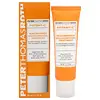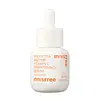What's inside
What's inside
 Key Ingredients
Key Ingredients

 Benefits
Benefits

 Concerns
Concerns

No concerns
 Ingredients Side-by-side
Ingredients Side-by-side

Water
Skin ConditioningNiacinamide
SmoothingDimethyl Isosorbide
SolventIsononyl Isononanoate
EmollientTranexamic Acid
AstringentDimethicone
EmollientCaprylic/Capric Triglyceride
MaskingAlpha-Arbutin
AntioxidantCetyl Alcohol
EmollientGlyceryl Stearate
EmollientPentylene Glycol
Skin ConditioningPropanediol
SolventC9-12 Alkane
SolventCitric Acid
BufferingGlyceryl Stearate Se
EmulsifyingButyrospermum Parkii Butter
Skin ConditioningTetrahexyldecyl Ascorbate
AntioxidantKojic Acid
AntioxidantResveratrol
AntioxidantTocopheryl Acetate
AntioxidantDiethylhexyl Syringylidenemalonate
Skin ProtectingHydrangea Arborescens Root Extract
Skin ConditioningMorus Alba Root Extract
BleachingScutellaria Lateriflora Extract
Skin ConditioningHydrolyzed Vegetable Protein
Skin ConditioningSilica
AbrasiveSodium Stearoyl Glutamate
CleansingCoco-Caprylate/Caprate
EmollientDimethiconol
EmollientGlycerin
HumectantSodium Phytate
Potassium Sorbate
PreservativeSodium Benzoate
MaskingCaprylyl Glycol
EmollientHexylene Glycol
EmulsifyingPolysorbate 20
EmulsifyingCeteth-20
CleansingSteareth-20
CleansingPolyacrylate Crosspolymer-6
Emulsion StabilisingPEG-75 Stearate
Titanium Dioxide
Cosmetic ColorantPhenoxyethanol
PreservativeWater, Niacinamide, Dimethyl Isosorbide, Isononyl Isononanoate, Tranexamic Acid, Dimethicone, Caprylic/Capric Triglyceride, Alpha-Arbutin, Cetyl Alcohol, Glyceryl Stearate, Pentylene Glycol, Propanediol, C9-12 Alkane, Citric Acid, Glyceryl Stearate Se, Butyrospermum Parkii Butter, Tetrahexyldecyl Ascorbate, Kojic Acid, Resveratrol, Tocopheryl Acetate, Diethylhexyl Syringylidenemalonate, Hydrangea Arborescens Root Extract, Morus Alba Root Extract, Scutellaria Lateriflora Extract, Hydrolyzed Vegetable Protein, Silica, Sodium Stearoyl Glutamate, Coco-Caprylate/Caprate, Dimethiconol, Glycerin, Sodium Phytate, Potassium Sorbate, Sodium Benzoate, Caprylyl Glycol, Hexylene Glycol, Polysorbate 20, Ceteth-20, Steareth-20, Polyacrylate Crosspolymer-6, PEG-75 Stearate, Titanium Dioxide, Phenoxyethanol
Water
Skin ConditioningPropanediol
Solvent1,2-Hexanediol
Skin ConditioningGlycerin
Humectant3-O-Ethyl Ascorbic Acid
Skin ConditioningButylene Glycol
HumectantLactobacillus Ferment Lysate
Skin ConditioningSqualane
EmollientHelianthus Annuus Seed Oil
EmollientDextrin
AbsorbentAcrylates/C10-30 Alkyl Acrylate Crosspolymer
Emulsion StabilisingCaprylic/Capric Triglyceride
MaskingTromethamine
BufferingXanthan Gum
EmulsifyingGluconolactone
Skin ConditioningCitrus Reticulata Peel Extract
Skin ConditioningPanthenol
Skin ConditioningNiacinamide
SmoothingAllantoin
Skin ConditioningDaucus Carota Sativa Root Extract
Skin ConditioningHyaluronic Acid
HumectantPentylene Glycol
Skin ConditioningSodium Metaphosphate
BufferingSilica Dimethyl Silylate
EmollientCyclodextrin
AbsorbentTocopherol
AntioxidantEthylhexylglycerin
Skin ConditioningMadecassoside
AntioxidantHydrogenated Poly(C6-20 Olefin)
AbrasiveProtease
ExfoliatingAscorbyl Tetraisopalmitate
AntioxidantGlutathione
Achillea Millefolium Extract
CleansingHdi/Trimethylol Hexyllactone Crosspolymer
Beta-Carotene
Skin ConditioningFerulic Acid
AntimicrobialWater, Propanediol, 1,2-Hexanediol, Glycerin, 3-O-Ethyl Ascorbic Acid, Butylene Glycol, Lactobacillus Ferment Lysate, Squalane, Helianthus Annuus Seed Oil, Dextrin, Acrylates/C10-30 Alkyl Acrylate Crosspolymer, Caprylic/Capric Triglyceride, Tromethamine, Xanthan Gum, Gluconolactone, Citrus Reticulata Peel Extract, Panthenol, Niacinamide, Allantoin, Daucus Carota Sativa Root Extract, Hyaluronic Acid, Pentylene Glycol, Sodium Metaphosphate, Silica Dimethyl Silylate, Cyclodextrin, Tocopherol, Ethylhexylglycerin, Madecassoside, Hydrogenated Poly(C6-20 Olefin), Protease, Ascorbyl Tetraisopalmitate, Glutathione, Achillea Millefolium Extract, Hdi/Trimethylol Hexyllactone Crosspolymer, Beta-Carotene, Ferulic Acid
 Reviews
Reviews

Ingredients Explained
These ingredients are found in both products.
Ingredients higher up in an ingredient list are typically present in a larger amount.
This ingredient is an emollient, solvent, and texture enhancer. It is considered a skin-softener by helping the skin prevent moisture loss.
It helps thicken a product's formula and makes it easier to spread by dissolving clumping compounds.
Caprylic Triglyceride is made by combining glycerin with coconut oil, forming a clear liquid.
While there is an assumption Caprylic Triglyceride can clog pores due to it being derived from coconut oil, there is no research supporting this.
Learn more about Caprylic/Capric TriglycerideGlycerin is already naturally found in your skin. It helps moisturize and protect your skin.
A study from 2016 found glycerin to be more effective as a humectant than AHAs and hyaluronic acid.
As a humectant, it helps the skin stay hydrated by pulling moisture to your skin. The low molecular weight of glycerin allows it to pull moisture into the deeper layers of your skin.
Hydrated skin improves your skin barrier; Your skin barrier helps protect against irritants and bacteria.
Glycerin has also been found to have antimicrobial and antiviral properties. Due to these properties, glycerin is often used in wound and burn treatments.
In cosmetics, glycerin is usually derived from plants such as soybean or palm. However, it can also be sourced from animals, such as tallow or animal fat.
This ingredient is organic, colorless, odorless, and non-toxic.
Glycerin is the name for this ingredient in American English. British English uses Glycerol/Glycerine.
Learn more about GlycerinNiacinamide is a multitasking form of vitamin B3 that strengthens the skin barrier, reduces pores and dark spots, regulates oil, and improves signs of aging.
And the best part? It's gentle and well-tolerated by most skin types, including sensitive and reactive skin.
You might have heard of "niacin flush", or the reddening of skin that causes itchiness. Niacinamide has not been found to cause this.
In very rare cases, some individuals may not be able to tolerate niacinamide at all or experience an allergic reaction to it.
If you are experiencing flaking, irritation, and dryness with this ingredient, be sure to double check all your products as this ingredient can be found in all categories of skincare.
When incorporating niacinamide into your routine, look out for concentration amounts. Typically, 5% niacinamide provides benefits such as fading dark spots. However, if you have sensitive skin, it is better to begin with a smaller concentration.
When you apply niacinamide to your skin, your body converts it into nicotinamide adenine dinucleotide (NAD). NAD is an essential coenzyme that is already found in your cells as "fuel" and powers countless biological processes.
In your skin, NAD helps repair cell damage, produce new healthy cells, support collagen production, strengthen the skin barrier, and fight environmental stressors (like UV and pollution).
Our natural NAD levels start to decline with age, leading to slower skin repair, visible aging, and a weaker skin barrier. By providing your skin niacinamide, you're recharging your skin's NAD levels. This leads to stronger, healthier, and younger looking skin.
Another name for vitamin B3 is nicotinamide. This vitamin is water-soluble and our bodies don't store it. We obtain Vitamin B3 from either food or skincare. Meat, fish, wheat, yeast, and leafy greens contain vitamin B3.
The type of niacinamide used in skincare is synthetically created.
Learn more about NiacinamidePentylene glycol is typically used within a product to thicken it. It also adds a smooth, soft, and moisturizing feel to the product. It is naturally found in plants such as sugar beets.
The hydrophilic trait of Pentylene Glycol makes it a humectant. As a humectant, Pentylene Glycol helps draw moisture from the air to your skin. This can help keep your skin hydrated.
This property also makes Pentylene Glycol a great texture enhancer. It can also help thicken or stabilize a product.
Pentylene Glycol also acts as a mild preservative and helps to keep a product microbe-free.
Some people may experience mild eye and skin irritation from Pentylene Glycol. We always recommend speaking with a professional about using this ingredient in your routine.
Pentylene Glycol has a low molecular weight and is part of the 1,2-glycol family.
Learn more about Pentylene GlycolPropanediol is an all-star ingredient. It softens, hydrates, and smooths the skin.
It’s often used to:
Propanediol is not likely to cause sensitivity and considered safe to use. It is derived from corn or petroleum with a clear color and no scent.
Learn more about PropanediolWater. It's the most common cosmetic ingredient of all. You'll usually see it at the top of ingredient lists, meaning that it makes up the largest part of the product.
So why is it so popular? Water most often acts as a solvent - this means that it helps dissolve other ingredients into the formulation.
You'll also recognize water as that liquid we all need to stay alive. If you see this, drink a glass of water. Stay hydrated!
Learn more about Water